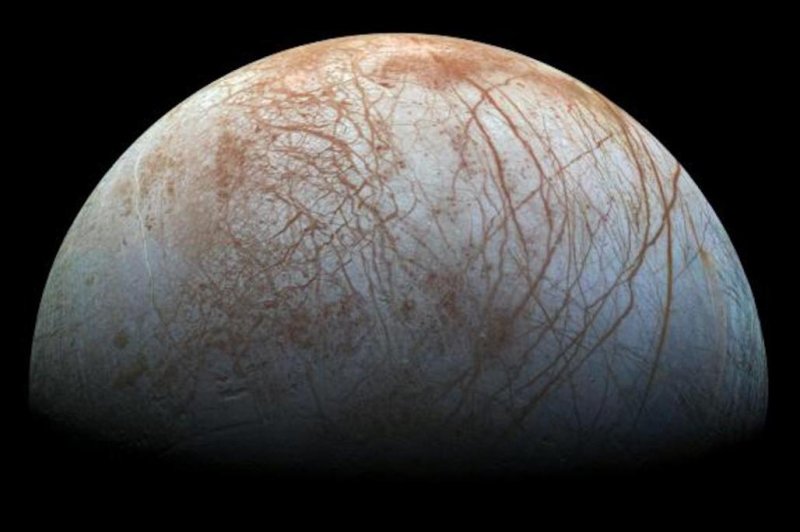Europa may host sinking tectonic plates. Photo by NASA/JPL-Caltech/SETI Institute
Dec. 4 (UPI) -- Scientists have found additional evidence of the tectonic plates on Jupiter's moon Europa.
According to the latest calculations in a computer model, Europa's icy shell can host subduction, the sinking of one tectonic plate beneath another.
Previous observations of Europa's surface revealed the presence of ice expansion similar in appearance to mid-ocean spreading ridges found in Earth's submarine basins.
"We have this evidence of extension and spreading, so the question becomes where does that material go?" Brandon Johnson, an assistant professor of planetary sciences at Brown University, said in a news release. "On Earth, the answer is subduction zones. What we show is that under reasonable assumptions for conditions on Europa, subduction could be happening there as well, which is really exciting."
Scientists believe the oceans beneath Europa's icy shell host the necessary conditions for life. The presence of subduction could strengthen their case, as descending land masses from the moon's surface could deliver oxidants and other chemicals -- food for microorganisms.
"If indeed there's life in that ocean, subduction offers a way to supply the nutrients it would need," Johnson said.
Differences in temperature and density drive subduction in Earth's mantle. Cooler, denser slabs are pulled deep into the mantle.
The latest modeling efforts by Johnson and his colleagues suggests similar dynamics are possible within Europa's icy shell. However, on Europa, salt gradients are more likely to drive subduction.
Ice melts much easier than rock does. On Europa, cold outer layers of ice would quickly warm as they descended into the warmer, lower ice layers. Differences in density would be dissolved and subduction would cease.
But when scientists added salt to the equation, they found the molecules act like little weights, pulling the icy slabs deeper and prolonging subduction. Previous observations suggest Europa features varying levels of salt. Upwelling in the subsurface ocean could encourage salt gradients, and cryovolcanism could spray salty water onto the surface of the moon's icy shell.
Johnson and his colleagues described the possibility of plate tectonics on Europa in a new paper published this week in the Journal of Geophysical Research: Planets.
"It's fascinating to think that we might have plate tectonics somewhere other than Earth," Johnson said. "Thinking from the standpoint of comparative planetology, if we can now study plate tectonics in this very different place, it might be able to help us understand how plate tectonics got started on the Earth."















